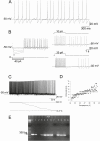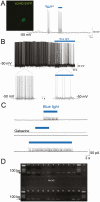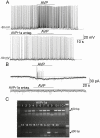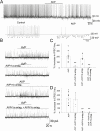Activation of Preoptic Arginine Vasopressin Neurons Induces Hyperthermia in Male Mice
- PMID: 33249461
- PMCID: PMC7758908
- DOI: 10.1210/endocr/bqaa217
Activation of Preoptic Arginine Vasopressin Neurons Induces Hyperthermia in Male Mice
Abstract
Arginine vasopressin (AVP) is a neuropeptide acting as a neuromodulator in the brain and plays multiple roles, including a thermoregulatory one. However, the cellular mechanisms of action are not fully understood. Carried out are patch clamp recordings and calcium imaging combined with pharmacological tools and single-cell RT-PCR to dissect the signaling mechanisms activated by AVP. Optogenetics combined with patch-clamp recordings were used to determine the neurochemical nature of these neurons. Also used is telemetry combined with chemogenetics to study the effect of activation of AVP neurons in thermoregulatory mechanisms. This article reports that AVP neurons in the medial preoptic (MPO) area release GABA and display thermosensitive firing activity. Their optogenetic stimulation results in a decrease of the firing rates of MPO pituitary adenylate cyclase-activating polypeptide (PACAP) neurons. Local application of AVP potently modulates the synaptic inputs of PACAP neurons, by activating neuronal AVPr1a receptors and astrocytic AVPr1b receptors. Chemogenetic activation of MPO AVP neurons induces hyperthermia. Chemogenetic activation of all AVP neurons in the brain similarly induces hyperthermia and, in addition, decreases the endotoxin activated fever as well as the stress-induced hyperthermia.
Keywords: AVPr1a receptor; AVPr1b receptor; arginine vasopressin; hyperthermia; medial preoptic area.
© The Author(s) 2020. Published by Oxford University Press on behalf of the Endocrine Society. All rights reserved. For permissions, please e-mail: journals.permissions@oup.com.
Figures











Similar articles
-
Opposing actions of co-released GABA and neurotensin on the activity of preoptic neurons and on body temperature.Elife. 2024 Aug 29;13:RP98677. doi: 10.7554/eLife.98677. Elife. 2024. PMID: 39207910 Free PMC article.
-
Effects of arginine vasopressin on firing activity and thermosensitivity of rat PO/AH area neurons.Neuroscience. 2012 Sep 6;219:10-22. doi: 10.1016/j.neuroscience.2012.05.063. Epub 2012 Jun 4. Neuroscience. 2012. PMID: 22677202
-
Arginine vasopressin differentially modulates GABAergic synaptic transmission onto temperature-sensitive and temperature-insensitive neurons in the rat preoptic area.Eur J Neurosci. 2018 Apr;47(7):866-886. doi: 10.1111/ejn.13868. Epub 2018 Mar 22. Eur J Neurosci. 2018. PMID: 29446159
-
Two ancient neuropeptides, PACAP and AVP, modulate motivated behavior at synapses in the extrahypothalamic brain: a study in contrast.Cell Tissue Res. 2019 Jan;375(1):103-122. doi: 10.1007/s00441-018-2958-z. Epub 2018 Dec 5. Cell Tissue Res. 2019. PMID: 30519837 Review.
-
The role of arginine vasopressin in thermoregulation during fever.J Neurosci Nurs. 2003 Oct;35(5):281-6. doi: 10.1097/01376517-200310000-00007. J Neurosci Nurs. 2003. PMID: 14593940 Review.
Cited by
-
The Role of Arginine-Vasopressin in Stroke and the Potential Use of Arginine-Vasopressin Type 1 Receptor Antagonists in Stroke Therapy: A Narrative Review.Int J Mol Sci. 2023 Jan 20;24(3):2119. doi: 10.3390/ijms24032119. Int J Mol Sci. 2023. PMID: 36768443 Free PMC article. Review.
-
Opposing actions of co-released GABA and neurotensin on the activity of preoptic neurons and on body temperature.Elife. 2024 Aug 29;13:RP98677. doi: 10.7554/eLife.98677. Elife. 2024. PMID: 39207910 Free PMC article.
-
A parabrachial-hypothalamic parallel circuit governs cold defense in mice.Nat Commun. 2023 Aug 15;14(1):4924. doi: 10.1038/s41467-023-40504-6. Nat Commun. 2023. PMID: 37582782 Free PMC article.
-
Opposing actions of co-released GABA and neurotensin on the activity of preoptic neurons and on body temperature.bioRxiv [Preprint]. 2024 Apr 17:2024.04.15.589556. doi: 10.1101/2024.04.15.589556. bioRxiv. 2024. Update in: Elife. 2024 Aug 29;13:RP98677. doi: 10.7554/eLife.98677. PMID: 38659782 Free PMC article. Updated. Preprint.
-
Vasopressin and Breathing: Review of Evidence for Respiratory Effects of the Antidiuretic Hormone.Front Physiol. 2021 Oct 26;12:744177. doi: 10.3389/fphys.2021.744177. eCollection 2021. Front Physiol. 2021. PMID: 34867449 Free PMC article. Review.
References
-
- Hoffman GE, McDonald T, Figueroa JP, Nathanielsz PW. Neuropeptide cells and fibers in the hypothalamus and pituitary of the fetal sheep: comparison of oxytocin and arginine vasopressin. Neuroendocrinology. 1989;50(6):633-643. - PubMed
-
- Ueta Y, Dayanithi G, Fujihara H. Hypothalamic vasopressin response to stress and various physiological stimuli: visualization in transgenic animal models. Horm Behav. 2011;59(2):221-226. - PubMed
-
- Richard P, Moos F, Dayanithi G, Gouzènes L, Sabatier N. Rhythmic activities of hypothalamic magnocellular neurons: autocontrol mechanisms. Biol Cell. 1997;89(9):555-560. - PubMed
Publication types
MeSH terms
Substances
Grants and funding
LinkOut - more resources
Full Text Sources
Molecular Biology Databases
Research Materials
Miscellaneous

